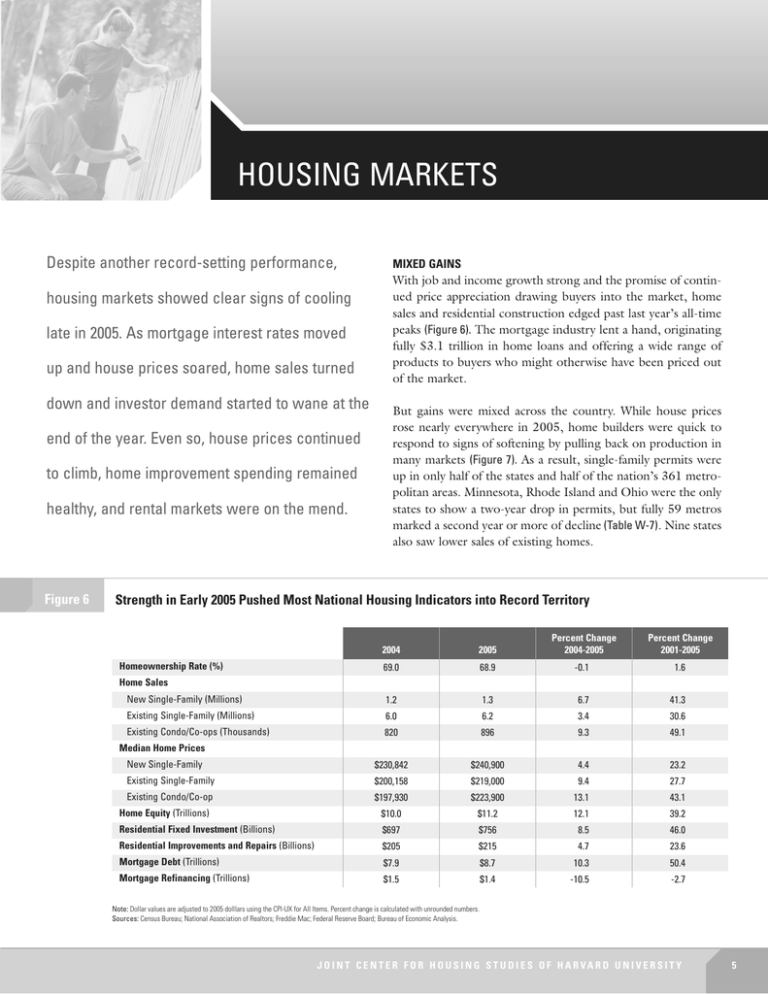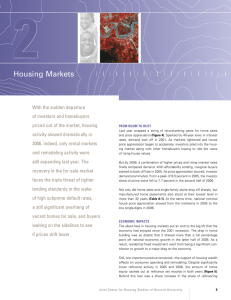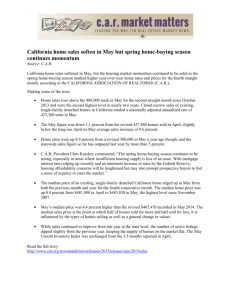HOUSING MARKETS Despite another record-setting performance,
advertisement

HOUSING MARKETS Despite another record-setting performance, housing markets showed clear signs of cooling late in 2005. As mortgage interest rates moved up and house prices soared, home sales turned down and investor demand started to wane at the end of the year. Even so, house prices continued to climb, home improvement spending remained healthy, and rental markets were on the mend. Figure 6 MIXED GAINS With job and income growth strong and the promise of continued price appreciation drawing buyers into the market, home sales and residential construction edged past last year’s all-time peaks (Figure 6). The mortgage industry lent a hand, originating fully $3.1 trillion in home loans and offering a wide range of products to buyers who might otherwise have been priced out of the market. But gains were mixed across the country. While house prices rose nearly everywhere in 2005, home builders were quick to respond to signs of softening by pulling back on production in many markets (Figure 7). As a result, single-family permits were up in only half of the states and half of the nation’s 361 metropolitan areas. Minnesota, Rhode Island and Ohio were the only states to show a two-year drop in permits, but fully 59 metros marked a second year or more of decline (Table W-7). Nine states also saw lower sales of existing homes. Strength in Early 2005 Pushed Most National Housing Indicators into Record Territory 2004 2005 Percent Change 2004-2005 Percent Change 2001-2005 69.0 68.9 -0.1 1.6 New Single-Family (Millions) 1.2 1.3 6.7 41.3 Existing Single-Family (Millions) 6.0 6.2 3.4 30.6 Existing Condo/Co-ops (Thousands) 820 896 9.3 49.1 New Single-Family $230,842 $240,900 4.4 23.2 Existing Single-Family $200,158 $219,000 9.4 27.7 Existing Condo/Co-op $197,930 $223,900 13.1 43.1 Home Equity (Trillions) $10.0 $11.2 12.1 39.2 Residential Fixed Investment (Billions) $697 $756 8.5 46.0 Residential Improvements and Repairs (Billions) $205 $215 4.7 23.6 Mortgage Debt (Trillions) $7.9 $8.7 10.3 50.4 Mortgage Refinancing (Trillions) $1.5 $1.4 -10.5 -2.7 Homeownership Rate (%) Home Sales Median Home Prices Note: Dollar values are adjusted to 2005 dolllars using the CPI-UX for All Items. Percent change is calculated with unrounded numbers. Sources: Census Bureau; National Association of Realtors; Freddie Mac; Federal Reserve Board; Bureau of Economic Analysis. JOINT CENTER FOR HOUSING STUDIES OF HARVARD UNIVERSITY 5 In the multifamily sector, vacancies generally fell and rents firmed. After rising steadily from 2000 through 2004, the national multifamily rental vacancy rate retreated to 2001–2002 levels last year. But even as markets revived, multifamily rental starts slid by 22,000 units to 203,000 in 2005. At the same time, multifamily starts of for-sale units rose by 29,000 to 149,000, and condo conversions surged as builders and property owners tried to cash in on the spectacular rise in prices. The manufactured housing sector continued to languish last year. Placements fell again from 124,200 in 2004 to 121,000 in 2005, weakening in every region except the West. Late in the year, however, demand for homes in the wake of Katrina’s devastation led to an increase in shipments. But this does not herald a reversal of below-trend growth for manufactured housing, which remains stunted by the withdrawal of competitively priced loans following heavy losses in the early 2000s. FUELING THE ECONOMY With rapidly appreciating house prices and relatively low interest rates, both cash-out refinances and second mortgage debt remained high in 2005 (Figure 8). Indeed, the amount of home equity cashed out in refinances set another record, up a whopping 66 percent to $243 billion in real terms. In the past three years alone, owners extracted $150 billion more in equity through refinancing than they had in the previous eight. Because interest rates on home equity lines of credit were rising faster than those on first mortgages, more borrowers viewed Figure 7 All this cash helped to fuel consumer and home improvement spending. Even owners who did not tap their equity felt more confident about spending because of their rapidly appreciating properties. While estimates vary, the housing wealth effects from strong appreciation contributed roughly one-third of the rise in real consumer spending in 2005 and added about half a percentage point to the real growth in the economy. Factoring in the contributions of home building and remodeling, the housing sector accounted for a full point of last year’s 3.5 percentage-point growth in GDP. Residential fixed investment was up by $59 billion in real terms to $756 billion, generating over 200,000 new construction jobs nationally. And by its broadest measure (including residential investment, commissions and fees to brokers and real estate agents, spending on furnishings and yards, and spending on rents and utilities), housing contributed a record 23 percent of the nation’s $12.5 trillion GDP in 2005. SIGNS OF SOFTENING Although 2005 surpassed 2004 on many measures, housing markets were clearly moderating. Indeed, the year-over-year change in sales of existing homes turned negative late in 2005. Single-Family Production Slipped in Half of the States Last Year Change in Permits, 2004–2005 ■ Decrease of 10% or More ■ Decrease of 5.0–9.9% ■ Decrease of 0.0–4.9% ■ Increase of 0.1–9.9% ■ Increase of 10% or More Source: Census Bureau, Construction Statistics. 6 cash-out refinancing as the better way to tap their equity. Nonetheless, homeowners still added $135 billion to second mortgage debt outstanding last year. Meanwhile, sellers cashed out about $73 billion of equity in realized capital gains that they did not reinvest in other homes (Table A-4). T H E S TAT E O F T H E N AT I O N ’ S H O U S I N G 2 0 0 6 Figure 8 properties to condominiums contributed to this near-term oversupply. While condo appreciation did slow modestly in response to rising inventories, the retreat came only after prices reached a new peak in the middle of last year. Homeowners Cashed Out Record Levels Of Home Equity in 2005 Billions of 2005 Dollars 500 450 400 350 300 250 200 150 100 50 0 Investor demand was up sharply in both 2004 and 2005, lifting the investor share of loans to the 9–10 percent range from 6–7 percent in 1999–2003 (Figure 9). Among the housing markets with the highest investor loan shares are several Florida and inland California metros, as well as Boise, Phoenix, and Las Vegas. In most markets, the investor share more than doubled from 2000 to 2005 (Table W-3). 1999 ■ 2000 2001 Cash-Out Refinances ■ 2002 Cashed Out at Sale 2003 ■ 2004 2005 Net Increase in Second Mortgage Debt Notes: Dollar values are adjusted for inflation by the CPI-UX for All Items. Equity cashed out at sale is defined as the proceeds that are not reinvested in another home. Sources: National Association of Realtors, Existing Single-Family Home Prices; Table A-4. Figure 9 Even new homes were a target for investors, especially in the hottest housing markets. Nationally, investors bought four percent of single-family homes built and 13 percent of condos sold by companies surveyed by the National Association of Home Builders in June 2005. But in the 30 large markets that posted the fastest price appreciation, investors snapped up an average of 11 percent of new single-family homes and 15 percent of condos. As the supply of homes for sale expands and the length of time on the market increases, investor demand should cool. If it does, it will be at least a year before it is clear how quickly these investment properties can be sold to owners who intend to use them as primary or second homes. In the hottest markets, the overhang of investor properties may be absorbed rapidly if housing production continues to fall. The recent sharp increase in vacant single-family homes for rent suggests, however, that this process will not be smooth. Investor and Second-Home Demand Has Boosted Home Sales Share of Prime Loan Origination Volume (Percent) 18 16 14 12 10 8 6 4 2 0 1999 ■ 2000 Investor Share ■ 2001 2002 2003 2004 2005 Second-Home Share Source: LoanPerformance. Much of the blame for this slowdown lies with the 1.56 percentage-point increase in adjustable mortgage rates and the 0.44 percentage-point increase in fixed mortgage rates from January 2005 to January 2006. With sales slowing but building activity steady despite widespread pullbacks, the inventory of both new and existing homes for sale ended the year much higher. Nevertheless, the 5.3–5.5 months’ supply in March 2006 was still below the 6.0 months’ mark that typically defines a buyer’s market. At the same time, the supply of condominiums for sale climbed from 3.9 months to 6.9 months. The rapid pace of conversions of existing rental Slowing house price appreciation and rising interest rates will pose the greatest challenges to low-income households that depend on their home equity to help finance their spending. Not only are the costs of borrowing on the increase, but the amount of equity available to tap is growing more slowly. Especially at risk are low-income homeowners with adjustablerate mortgages who are seeing their monthly payments ratchet up even without additional borrowing. HOUSE PRICE TRENDS Until 2000, nationally weighted average home prices rose closely in line with median household incomes and general price inflation. Since then, however, house price appreciation has shot ahead of these benchmarks, outstripping income growth more than six-fold from 2000 to 2005. As a result, the median house price exceeded the median household income by at least four times in a record 49 of 145 metro areas, and by more than six times in 14 metros (Figure 10). By 2005, nominal house prices were rising at their fastest pace since 1978 (Table W-1). Inflation-adjusted prices were up 9.4 JOINT CENTER FOR HOUSING STUDIES OF HARVARD UNIVERSITY 7 percent, the largest increase in more than 40 years of recordkeeping. It is no surprise, then, that media reports of a housing bubble reached a fever pitch last year. According to Factiva, the number of articles mentioning that term increased to 3,492 in 2005, up from 789 in 2004, 614 in 2003, and 907 in 2002. But, when and if house prices do fall, the so-called bubble is more likely to deflate slowly rather than burst suddenly. History suggests that appreciation eases for a year or two before prices come down in nominal terms. While dips of a few percentage points are common, nominal house prices rarely drop by 10 percent or more. Figure 10 Since 1999, House Prices Have Rocketed Past Incomes in Most Metros Number of Metros 145 120 Still, over the past 30 years, nominal house prices have in fact fallen by five percent or more at least once in about half of the nation’s 75 largest metros. In most cases, it takes significant job losses—or a combination of overbuilding, modest job losses and population outflows—to drive house prices down substantially. In terms of magnitude, price declines associated with episodes of major job losses alone average 4.5 percent, while those occurring in and around periods of overbuilding alone average 8.3 percent (Figure 11). While low interest rates certainly helped, house prices probably continued to appreciate throughout the last recession simply because these two conditions were absent. In 2001, none of the large metros experienced nearly the level and duration of job losses seen during the previous two cycles. Equally important, building activity has been much less intense. In metros experiencing major house price declines in the past, three-year average development levels exceeded the 20-year median by about 74 percent (Table W-4). In 2001–2004, development in these same metros was only ten percent above normal. These signs of moderation provide good reason to believe that the next house price correction will be milder than in the past. 95 70 45 20 1994 1999 2004 2005 Ratio of Median House Price to Median Household Income: ■ Less than 3.0 ■ 3.0–3.9 ■ 4.0–4.9 ■ 5.0–5.9 ■ 6.0–6.9 ■ 7.0 or More Source: Table W-2. Figure 11 HOME ENERGY CONSUMPTION The increase in energy costs over the past two years has placed new hardships on low-income households. As last measured in 2003, fully 2.5 million households in the bottom income quartile spent more than 30 percent of their budgets on home energy costs even before the sharp run-up in oil prices. Another 1.4 million households spent 20–30 percent of their incomes on home energy. Overbuilding and Job Losses Are Often Preconditions for Metro Area House Price Declines Percent of Times That Various Conditions Led to a Price Decline, 1975–1999 Average Nominal House Price Decline, 1995–1999 (Percent) Minor Employment Loss and No Overbuilding Minor Employment Loss and No Overbuilding Overbuilding Only Overbuilding Only Minor Employment Loss and Overbuilding Minor Employment Loss and Overbuilding Major Employment Loss and No Overbuilding Major Employment Loss and No Overbuilding Major Employment Loss and Overbuilding Major Employment Loss and Overbuilding 0 20 40 60 80 100 0 5 10 Notes: Includes the 75 largest metros based on 2000 population. Major (minor) employment loss is defined as periods of net decreases of at least 5% (under 5%). Overbuilding is defined as periods when one- to three-year average annual permitting levels per 1,000 residents are at least double the 1980–2004 median annual level for that metro. Sources: Freddie Mac Conventional Mortgage Home Price Index; Census Bureau, Construction Statistics; Bureau of Labor Statistics. 8 T H E S TAT E O F T H E N AT I O N ’ S H O U S I N G 2 0 0 6 15 Figure 12 Newer Homes Are Far More Energy Efficient Annual Energy Consumption per 1,000 Sq. Ft. (Dollars) 900 800 700 600 500 400 Northeast Year Built: ■ Pre-1960 ■ Midwest 1960-1969 ■ 1970-1979 ■ 1980-1989 South ■ West 1990-2001 Source: JCHS tabulations of the 2001 Residential Energy Consumption Survey. The recent jump in prices has yet to last as long as in the 1979–1983 energy crisis, when the price of imported oil averaged $76 a barrel in real terms. In response to the first oil price shock, households tried to conserve energy by making modest changes such as turning down thermostats and, to a lesser extent, adding insulation. Over time, though, adoption of stricter building and product standards has improved the efficiency of the housing stock. Indeed, even many older homes are now more energy-efficient as homeowners replace windows, doors, and heating and cooling systems in the normal course of maintenance. Whether the recent jump in energy costs leads to more significant retrofitting remains to be seen. Despite improvements to many existing units, newer homes consume far less energy on average than older ones (Figure 12). After adjusting for differences in the regional mix of housing, homes built since 1990 use 8.5 percent less energy per square foot than those built in the 1980s, 17.0 percent less than those built in the 1970s, 17.5 percent less than those built in the 1960s, and 22.7 percent less than those built before 1960. These improvements have offset the higher costs of heating and cooling today’s ever-larger homes. As a result, while new homes are almost a third larger on average than units built in the 1960s, they only consume 10 percent more energy (Table A-11). It is important to note that higher energy costs also hit those who rely on automobiles for long, repeated trips. In the West, average travel-related energy costs are actually higher than home energy costs. Elsewhere, though, the burden of rising energy costs falls hardest on the housing side of the family budget. THE OUTLOOK The most immediate risks to the housing market now come from the rise in interest rates, the erosion of affordability after years of strong house price appreciation, and the growing inventory of both new and existing homes for sale. But unless the broader economy stumbles and job losses mount, home sales and construction activity will likely dip only modestly. House price appreciation should also remain positive in most markets. Rising house prices, in turn, will encourage further home equity borrowing and spending, although the pace of borrowing will slow if interest rates keep climbing. Housing’s contribution to economic growth is already diminishing and will begin to turn negative if home sales, starts, and home equity borrowing continue to decline. Over the longer term, the outlook for housing markets is favorable. With household growth accelerating and second-home demand climbing, the number of conventional homes completed and manufactured homes placed in the coming decade should easily exceed the 18.1 million units added from 1995 to 2004. In addition, improvements in the mortgage finance system over the past several years, together with stricter inventory management in the home building industry, will help to dampen boom-bust cycles in the future. As a result, housing production should average more than two million units annually over the next ten years. ■ JOINT CENTER FOR HOUSING STUDIES OF HARVARD UNIVERSITY 9


